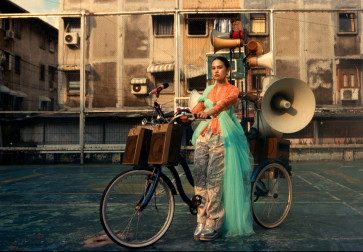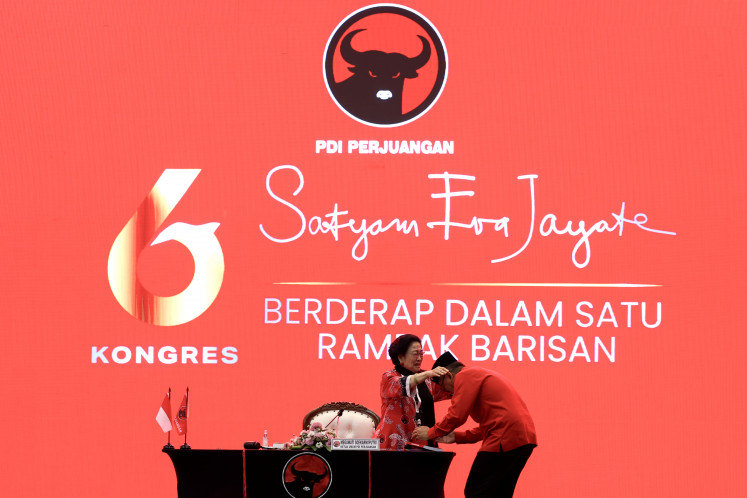Popular Reads
Top Results
Can't find what you're looking for?
View all search resultsPopular Reads
Top Results
Can't find what you're looking for?
View all search resultsIn loving memory of Christmas cards
A friend recently sent a text message saying he had just received a Christmas and New Year card
Change text size
Gift Premium Articles
to Anyone
A friend recently sent a text message saying he had just received a Christmas and New Year card.
“Greeting cards are now rare and I long for them,” he said, adding that the sender was Mitra Hadiprana Gallery, an art gallery and architecture firm in Jakarta.
When asked about the greeting card, the gallery happily confirmed that it sent out cards for various occasions throughout the year.
“We actually preserve the tradition of [sending] printed cards with our own designs. Other than for Christmas and New Year, we also have cards for Idul Fitri and other holidays. These cards are not just to be viewed, but also function as memorabilia,” said Puri Hadiprana, the gallery’s commissioner.
Graphic design circles indicate that printed greeting cards have been part of “memory lane” for some 15 year now.
The late Sutripto D. Sasomo, a designer of unique cards through Trips Graphic Art, once said that by 2010, the circulation of greeting cards had shrunk by 20 percent. So, if printed greeting cards are still offered at some shops, they are usually left-overs of previous years’ stock.
In fact, the days of greeting cards of all sorts are numbered, including those of special value created by artists with disabilities under the Association of Mouth and Foot Painting Artists (MFPA).
The sale of their products, which are available online across the world, has received a meager response. However, the artists rely entirely on these cards for a living.
It is common knowledge that the dwindling circulation of such cards is because nowadays, the public prefers to use digital media, such as WhatsApp or social media platforms, to send out their greetings.
In their heyday, Christmas cards simultaneously expressed New Year’s greetings and were collected not only for their creative and beautiful designs, but for also including messages that were philosophical and reflective. Many of them even presented social issues by unveiling traces of complex cultural journeys.
For example, a Christmas card I once came across featured a picture of Batara Kresna (Lord Krishna) in a shadow puppet design. The Hindu icon was depicted in an alert and respectful position, with the words “Merry Christmas” written above him.
Also entering the Christian world was Batara Guru or Manikmaya (Lord Shiva), another icon often discussed in the Javanese-Islamic context who once posed mounted on the sacred bull Lembu Nandinya.
Such images inevitably serve to indicate how creatively designed Christmas cards can convey various significant meanings through the stories and symbols illustrated. These representations invite people to exercise self-reflection amid the decorative Christmas lights on their way to welcoming the New Year.
Artists, like creators of greeting cards, are often religious people who instinctively understand the necessity for symbolism that is spontaneous as well as invocative. It is because the world of symbols is the major element with which to manifest their artistic ideas.
Only through symbols can their works communicate more easily with their admirers. Symbols constitute the hidden power revealed by artists, as Scottish author John Buchanan put it.
In the 1990s, Balinese artist Ketut Lasia created images of the birth of Jesus for Christmas cards.
Lasia crafted symbolic images based on Balinese culture, presenting Bali’s landscape, nature and temples as important Hindu element in his Christian-themed pictures. By doing so, he suggested that the celebration of one religion is also the joy of other faiths.
With the lapse of time, Christmas greetings today are sent as digital cards or simple greetings via messaging services, which can also be interesting.
But what has so far emerged remains limited to attractive and funny images that are sheer entertainment in value; visual attractions that offer a broader horizon of thought and deeper faith have yet shown up.
Meanwhile, the fleeting glimpses of digital cards bring blinking messages that will shortly vanish without a trace.
Many hope that the visual content of some greeting cards found in the printing era can be adopted by modern-day creators of digital media cares and processed in the gadgets that promise a thousand marvels.










